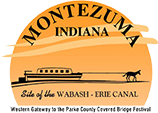 The town of Montezuma was settled in 1821, when Samuel West built a log home here. The town was formally established in 1823, and by 1824, the settlement had forty occupants. The origin of the town’s name remains a mystery. The name of the famous Aztec emperors Montezuma I and Montezuma II may have been chosen because of the many Native American settlements and later Native American reservation in the area. Also, the name Montezuma was in the news when in 1820, the 94 mile middle section of the famous Erie Canal in New York was completed connecting Utica to the town of Montezuma on the Seneca River. Encouraged by the success of the Erie Canal, Indiana began the Wabash-Erie Canal project to connect Ft. Wayne to the Ohio River. Montezuma became an important port on the canal and the “turn-around basin” (Benson’s Basin) and remnants of the canal can still be seen adjoining Reeder Park. Warehouses and loading docks surrounded the basin as passengers and area products such as livestock, lumber, and grain were loaded and dispatched to New Orleans or the Great Lakes. Canal boats would frequently spend the winter in the basin while they waited for the canal to thaw in the Spring.
The town of Montezuma was settled in 1821, when Samuel West built a log home here. The town was formally established in 1823, and by 1824, the settlement had forty occupants. The origin of the town’s name remains a mystery. The name of the famous Aztec emperors Montezuma I and Montezuma II may have been chosen because of the many Native American settlements and later Native American reservation in the area. Also, the name Montezuma was in the news when in 1820, the 94 mile middle section of the famous Erie Canal in New York was completed connecting Utica to the town of Montezuma on the Seneca River. Encouraged by the success of the Erie Canal, Indiana began the Wabash-Erie Canal project to connect Ft. Wayne to the Ohio River. Montezuma became an important port on the canal and the “turn-around basin” (Benson’s Basin) and remnants of the canal can still be seen adjoining Reeder Park. Warehouses and loading docks surrounded the basin as passengers and area products such as livestock, lumber, and grain were loaded and dispatched to New Orleans or the Great Lakes. Canal boats would frequently spend the winter in the basin while they waited for the canal to thaw in the Spring.
Montezuma was an important trading post in the area for Miami Native American settlements. However, the town did not did not flourish until the Wabash and Erie Canal was built. The canal started in the northern part of the state in 1836, had reached Lafayette by 1843, and by 1848, it had reached Montezuma. Eventually, the canal extended to Evansville. It was 460 miles long and was the longest canal ever built in America. The railroads spelled doom for the canal and it started to decline shortly after it was finished. It ceased operation completely in 1874, and ultimately bankrupted the state of Indiana. Evidence of the canal is still visible in many places, but it has completely disappeared in others.
By 1857, the railroads were replacing canals and soon two major rail lines intersected in Montezuma. Passengers and freight on the line from Washington D.C. to Springfield, IL, would often stop over here in order to transfer to the line running from Chicago to Miami.
Five major types of clay abounded in the Montezuma area and many local brickyards produced bricks for homes, fireplaces and roads. Because of the railroad connection, much of Chicago was rebuilt with clay products from the Montezuma area after the Chicago Fire in 1871.
In 1906, the Montezuma Sanitarium & Hotel opened and offered the curative powers of the sulphur-containing waters from an artesian well located just south of the canal basin. A large swimming pool surrounded by dressing rooms offered to cure bathers of Rheumatic Gout, stomach trouble, Chronic Malaria, and many other diseases. The Sanitarium’s forty beautifully furnished rooms mysteriously burned in the 1930s.
Montezuma is situated in the southwest corner of Reserve Township, on the Wabash River, and was early a place of considerable importance, being the principal shipping point in this part of the county during the early years of settlement, when the Wabash was the great commercial highway of this western country. On the completion of the Wabash and Erie Canal in 1850, the town took a fresh start and from that date to 1860 was the most prosperous period it ever experienced.
Facts about Montezuma, Indiana:
- Elevation: 501 feet above sea level
- Montezuma is positioned 39.79 degrees north of the equator and 87.36 degrees west of the prime meridian.
- Other nearby communities include Mecca, Newport, Fairview Park, Dana, Bloomingdale, Clinton, Rockville, and Cayuga.
- Land Area: 1.538 square kilometers or 0.6 square miles
- Amount of Surface Water: 0 square kilometers
